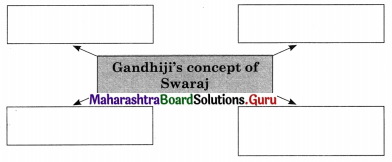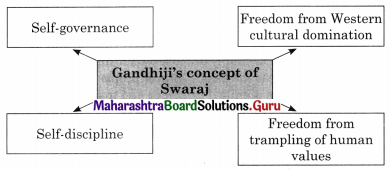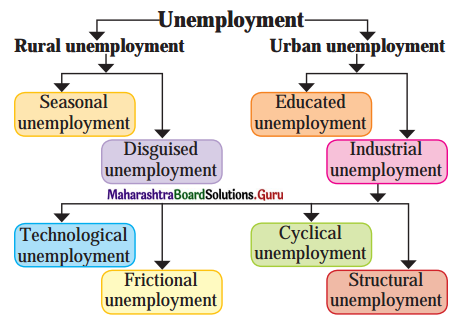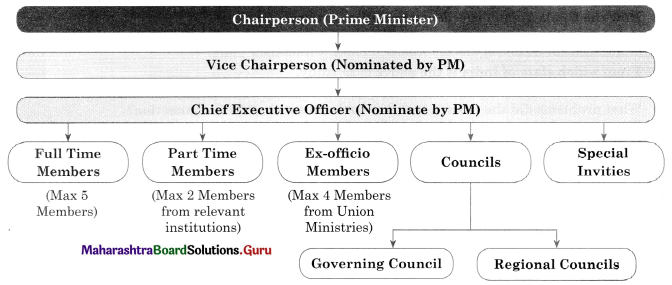Balbharti Maharashtra State Board Class 11 Political Science Important Questions Chapter 4 Constitutional Government Important Questions and Answers.
Maharashtra State Board 11th Political Science Important Questions Chapter 4 Constitutional Government
1A. Choose the correct alternative and complete the following statements.
Question 1.
Constitution of the ____________ was made by the Constitutional Convention. (USA, UK, India, France)
Answer:
USA
Question 2.
The Magna Carta has it’s origin in ____________ (USA, England, France, Cuba)
Answer:
England
![]()
Question 3.
Till, recently the doctrine of absolute Parliamentary Sovereignty existed in ____________ (USA, Mexico, Argentina, UK)
Answer:
UK
Question 4.
____________ is an example of a ‘Holding Together’ federation. (USA, India, UK, Portugal)
Answer:
UK
Question 5.
____________ is an example of a ‘Coming Together’ federation. (USA, India, UK, Portugal)
Answer:
USA
Question 6.
Protection of rights is entrusted to the ____________ (Legislature, Executive, Civil Services, Judiciary)
Answer:
Judiciary
Question 7.
A ____________ system functions on ‘Separation of Powers’ theory. (dictatorship, parliamentary, presidential, federation)
Answer:
Presidential
1B. Identify the incorrect pair in every set, correct it and rewrite.
Question 1.
(a) England – Republic
(b) USA – Federation
(c) Portugal – Unitary System
Answer:
(a) England – Constitutional Monarchy
![]()
Question 2.
(a) Union List – Defence
(b) State List – Atomic Energy
(c) Concurrent List – Education
Answer:
(b) Union list – Atomic energy or State list – Public health and sanitation
Question 3.
(a) Senate – USA
(b) Rajya Sabha – India
(c) House of Lords – Brazil
Answer:
(c) Houses of Lords – England
1C. State the appropriate concept for the given statement.
Question 1.
The idea that there should be limitations on powers of the government.
Answer:
Constitutionalism
Question 2.
First ten amendments to the American constitution.
Answer:
Bill of Rights
Question 3.
Type of government in which Head of State assumes his/her position on a hereditary basis.
Answer:
Monarchy
Question 4.
Process of bringing out changes in some provisions of the constitution.
Answer:
Amendment
![]()
Question 5.
The manner in which those who hold power are expected to behave.
Answer:
Constitutional Morality
Question 6.
Executive in a parliamentary system in whose name all powers are exercised.
Answer:
Nominal Executive
1D. Answer in one sentence.
Question 1.
What is the modern view of constitutionalism?
Answer:
The modern view of constitutionalism is the idea of restricting the powers of the government as a whole.
Question 2.
Explain the doctrine of Parliamentary Sovereignty.
Answer:
The doctrine of Parliamentary Sovereignty means that the Parliament which represents the citizens has the power to make laws with no restrictions on it’s jurisdiction.
![]()
Question 3.
What was the ruling in the Kesavananda Bharati case?
Answer:
The ruling in the Kesavananda Bharati case was that ‘the basic structure of the constitution could not be altered by any amendments carried out by the legislature.
Question 4.
What is Constitutional Morality?
Constitutional Morality refers to the values which are the foundation of the constitution and the manner in which those in political power are expected to behave.
Question 5.
In a Parliamentary system who constitutes the real executive?
Answer:
The Prime Minister and the Council of Ministers i.e., the Ministry constitute the real executive in a Parliamentary System.
Question 6.
Name the two kinds of executive in a parliamentary system of government.
Answer:
The two kinds of executive in a parliamentary system of Government are nominal executive and real executive.
Question 7.
Name the two houses of legislature in the following:
- Indian
- England
- USA
Answer:
- India – Lok Sabha, Rajya Sabha
- England – House of Commons, House of Lords
- USA – Senate, House of Representatives
![]()
Question 8.
What is the ‘veto power’ of US President The US President has the right to reject a law passed by the legislature. This is the ‘veto power’.
Question 9.
What is the unitary system of Government?
Answer:
Countries with small territory usually have a single government at the centre which is called unitary government.
Question 10.
What is the significance of the Seventh Schedule?
Answer:
The Seventh Schedule consists of the Union, State and the Concurrent lists on the basis of which government powers are distributed in India.
1E. Find the odd word out in the given set.
Question 1.
USA, UK, India, Australia.
Answer:
UK (not a federation)
Question 2.
USA, Brazil, Argentina, Japan.
Answer:
Japan (not a presidential system)
Question 3.
USA, Canada, Australia, India.
Answer:
India (not a ‘coming together’ federation)
2A. State whether the following statements are true or false with reasons.
Question 1.
Indian Constitution is enacted.
Answer:
This statement is True.
- The Indian Constitution was framed by the Constituent Assembly of India which functioned from December 1946 till November 1949.
- It is a product of detailed discussions, debates and deliberations. The constitution came into force on 26th January 1950.
![]()
Question 2.
Today the doctrine of Parliamentary Sovereignty no longer exists in it’s absolute form in the United Kingdom.
Answer:
This statement is True.
- According to the doctrine of Parliamentary Sovereignty, the Parliament has the authority to make any law and the only control mechanism is a vigilant public opinion.
- Today, the United Kingdom is a member of various international organizations and signatory to many international agreements which guarantee individual rights and restrict parliamentary powers.
Question 3.
In a parliamentary system, the Head of State is powerful.
Answer:
This statement is False.
- A parliamentary system makes a distinction between the Head of State and Head of government. The Head of State is the nominal executive. While the Prime Minister and his/her council are the head of government.
- All decisions and administration is conducted in the name of the nominal executive (President) by the real executive (Prime Minister and his/her Council of Ministers.)
2B. Complete the concept maps.
Question 1.

Answer:

Question 2.

Answer:

![]()
Question 3.

Answer:

3. Express your opinion of the following.
Question 1.
The Presidential System may lead to a deadlock in government functioning.
Answer:
The President is both Head of State and Head of government. He/she is directly elected by the people for a fixed tenure for e.g., US President is elected for a 4 year tenure. There is only one executive. The legislature (Congress in the USA) is also directly elected by the citizens.
There exists a separation of legislative and executive powers as well as a system of ‘checks and balances’ for e.g., Legislature can impeach the President, while the President can exercise the ‘Veto Power’ to reject any law passed by the Legislature.
Thus, there can be an impasse in government functioning for e.g., since President Trump assumed office- there have been many cases of a standoff between the office of the President and the US Congress, especially the Democrats. In 2019, the Congress voted to overturn President Trump’s emergency declaration to build a border wall with Mexico. In turn, the President ‘vetoed’ this vote.
4. Answer the following questions.
Question 1.
Explain the nature of Indian Federation.
Answer:
In India, at the time of independence, there were Princely States and areas under British administration. The States were created after independence on the basis of language i.e., linguistic reorganisation of States. The Union Government created the States. The journey of Indian Federalism has been mixed. After independence, the States had been granted additional powers. However, later economic and technological changes had led to the enhancement of the powers of the Central government.
![]()
The Indian Federation differs greatly from the US federation. India has been described as ‘quasi-federation’ or a ‘federation with an unitary spirit’ as the division of powers favors the central government for e.g., it has full control over the Union list and Residuary subjects and it’s laws have precedence over state legislations even in case of the subjects in Concurrent list.
Question 2.
Explain the components of a Constitution.
Answer:
The constitution is the highest law of the country. It reflects the objectives of the state and the rights and aspiration of its citizens. It establishes the rule of law and sets limits on government authority. A constitution is a living document that indicates the way in which a country is governed. The primary function of the constitution is to lay out the basic structure of the government according to which the people are to be governed.
A constitution has three distinct but interrelated components.
- Set of Rules – A constitution is a set of rules that describes the structure, powers and functions of the three organs of government to ensure that each organ functions without its jurisdiction. It lays down the limitations on what the government can do or cannot do.
- Set of Rights – A constitution lists the rights of the citizens, means for protection of this rights and the duties of citizens. It also lists the means of protecting the rights e.g., in India, the judiciary is entrusted with protecting the rights. The rights guaranteed by the constitution are not unlimited i.e. they are subject to reasonable limitations.
- Set of Objectives and Values – A constitution enumerates the values and objectives that it seeks to fulfill. For e.g., Indian Constitution seeks to ensure the values of justice, liberty and equality.
Question 3.
Explain Parliamentary system.
Answer:
The two main types of democratic governments are Parliamentary System (as seen in the United Kingdom, India, Canada, Australia, Japan, etc.) and Presidential System (which exists in the United State of America, Argentina, Mexico, Brazil, etc.). This distinction is mainly based on the nature of Legislature-Executive relationship.
Parliamentary System – It makes a distinction between Head of State (President of India) and Head of Government (Prime Minister and his Council of Ministers).
The main features of the parliamentary system are:
- There is a fusion of legislature and executives powers. The executive i.e., the ministry is drawn from the legislature and is subordinate to it. Ministers are also members of Parliament.
- There are two executives i.e., nominal (President of India or Monarch in England) and real (ministry). All powers are exercised by the real executive although it is conducted in the name of the nominal executive.
- It is a responsible government- The Prime Minister and the Council of Ministers stay in power only as long as they have the required majority in the Parliament. In case, the Ministry loses majority support, the Prime Minister along with his Council of Ministers has to resign.
- It may exist either as Republics or as Constitutional Monarchies depending on the nature of the nominal executive. In a Republic, the nominal executive is elected while in a Monarchy, he/she assumes position on the basis of heredity.
- Most Parliamentary systems have a Bicameral Parliament for e.g., in England, Parliament consists of House of Commons (lower house-directly elected)] and House of Lords (Upper house hereditary basis)
![]()
Question 4.
Explain Presidential system.
Answer:
The main features of Presidential system are:
- The President who is directly elected by the citizens for a fixed tenure is both, Head of State and Head of Government.
- Thus, there is only one executive.
- The Legislature is also directly elected. Members of the executive are not permitted to belong to the legislature.
- There exists a separation of legislative and executive powers as well as a system of checks and balances for e.g.
- The legislature can impeach the President while the President, can exercise the ‘Veto Power’ to reject any law passed by the
- Legislature.
- The President can continue in office irrespective of whether or not he/she enjoys majority support in the Legislature.
Question 5.
What are the two processes of forming a Federation?
Answer:
Federation may be performed by two processes-
- Small political units ‘come together to establish a single, large political unit for e.g., thirteen colonies came together to fight for independence from British rule and the US federation came into being. This is called centripetal process.
- States are created by the union government for e.g., in India, States were reorganized on the basis of language and other regional aspirations. This is the centrifugal process.
Question 6.
Explain Unitary System of Government.
Answer:
Countries that are small in size prefer to have a single, central, government. This is called the Unitary System. It is seen in Cuba, France, Bolivia, Israel, Portugal, Sri Lanka, etc, Some hitherto unitary systems change to a quasi-unitary form, through establishment of provinces and distribution of political power to somewhat autonomous units, for e.g., UK has an unitary system. However, it’s regions i.e. Scotland, Wales, Northern Ireland have their own assemblies with some degree of autonomy. These are known as ‘Holding Together’ federations.
Question 7.
Write about the Seventh Schedule of Indian Constitution.
Answer:
The Seventh Schedule of the constitution contains three lists i.e., the Union List, the State List and the Concurrent List. Each list contains subjects over which the Central Government, The State Governments (as far as their respective states are concerned), or both the governments can take decisions and make laws respectively. In cases where both the Central and State governments have made laws about subjects falling in the Concurrent List, then the decision of the former prevails. Furthermore, the State Governments can also ask the Central Government to make laws on subjects included in the State List, if such a need arises.
![]()
Question 8.
Explain Basic Structure Doctrine.
Answer:
The Supreme Court of India, in the celebrated Keshavananda Bharati (1973) laid down the restrictions on the power of the Government to amend the Constitution. It ruled that the Constitution of India possessed a basic structure which could not be altered in any manner, and that other than this there were no restrictions on the power of parliament to amend the Constitution. This is known as Basic Structure Doctrine.
5. Answer the following in detail with reference to the given points.
Question 1.
Explain Federation.
(i) What is a federation?
(ii) Features of a federation.
(iii) Processes of forming a federation.
(iv) Quasi-federal nature of Indian Federation.
Answer:
(i) A federation refers to a political structure in which there are two sets of governments i.e. one for the whole country and governments in each of the federal units (called Provinces or States). There is a distribution of powers between the Federal government (also known as Union or Central Government) and the State Governments. Federal governments are preferred in countries having large size and heterogeneous population.
(ii) The main features of a federation are
- Dual set of governments i.e., Union government and State governments.
- Division of power between the two sets of governments for e.g., in India, jurisdiction is distributed between the Union (Centre) and States on the basis of Union, State and Concurrent list (as stated in Seventh Schedule of the Constitution)
- A written constitution to enable a clear distribution of government powers.
- Independent judiciary to resolve center-state or state-state disputes.
(iii) Federation may be performed by two processes
- Small political units ‘come together to establish a single unit for e. g., thirteen colonies came together to fight for independence from British rule and the US federation came into being. This is called centripetal process.
- States are created by the union government for e.g., in India, states were reorganized on the basis of language and other regional aspirations. This is the centrifugal process.
![]()
(iv) India has been described as ‘quasi-federation’ or a ‘federation with an unitary spirit’ as the division of powers favors the central government for e.g. it has full control over the Union list as well as over residuary subjects. It’s laws have precedence even in case of the subjects in Concurrent list.
















